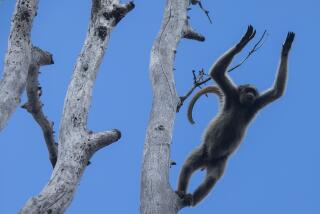Ringed In by Warfare, Mountain Gorillas Survive
BALTIMORE — Kenneth Cameron got the emergency call after only a few months in Rwanda. A young female mountain gorilla had a snare around her ankle and was in danger of losing a foot, maybe her life.
What he didn’t know when he headed for the Congo forest was that she had a protector--a 400-pound male gorilla who dealt with the human interloper by sitting on him.
“He came walking over, turned and sat on one leg, reached over my head and grabbed some leaves and ate for several minutes while he had me pinned,” Cameron said.
Cameron, an associate veterinarian at the Cincinnati Zoo, is in the midst of a two-year stint with the Mountain Gorilla Veterinary Project, which tries to monitor the health of the rare animals. Mike Cranfield, head veterinarian of the Baltimore Zoo, is the project’s director.
The gorilla project was established by the Denver-based Morris Animal Foundation in 1985, the year gorilla expert Dian Fossey was killed at her camp in Parc National des Volcans in Rwanda, where she studied the animals for 18 years and waged a personal war to protect them from poachers.
Ethnic Conflicts a Barrier to Scientists
For nearly a decade, scientists have been stymied in their efforts to help mountain gorillas because of ethnic fighting near their home--a densely forested volcanic mountain range at the borders of Rwanda, Uganda and the Congo.
Parc National des Volcans, where the gorillas live at elevations between 9,000 and 13,000 feet, has become so dangerous that Cameron has been unable to visit the project’s veterinary center in the park in Kinigi since his arrival in June 1997.
Fossey’s camp, Karisoke, has been stripped of lumber and metal sheeting. Several times the project’s center has been looted and destroyed.
The military recently provided an escort for trackers with the Atlanta-based Dian Fossey Gorilla Fund, another research group that collaborates with the Mountain Gorilla Veterinary Project, to count Fossey’s gorillas.
Trackers found 63 gorillas in September representing two of Fossey’s original three groups. The next month they located the third group of 16, a bit smaller than when last counted in the 1980s. Two infants were among the groups.
“It is surprising, with the turmoil, that the gorillas are still around and appear to be doing all right,” said Dieter Steklis, the gorilla fund’s chief scientist.
Cranfield, who returned from a two-week visit late last year, said he’s hopeful the veterinary center can be reopened in the next few months.
“Rwanda is much more settled, and we were able to make it to the edge of the park,” he said.
The number of mountain gorillas left is in dispute. None live in captivity. About 300 are believed to live in parks in Rwanda, Congo and Uganda. A second population of smaller gorillas with broader faces in the Bwindi Impenetrable National Park in Uganda could double that number, depending upon whether they are mountain gorillas or a subspecies.
Genetic testing indicates that the two gorilla groups are genetically the same, but scientists want more testing to determine whether the Bwindi gorillas, which live at lower altitudes, are truly mountain gorillas. The two groups are divided by a large swath of farmland in a broad valley in the volcanic mountain range.
Normally, Cameron would expect to provide emergency veterinary care for at least two or three injured gorillas a year. But the call in October 1997 was a rare opportunity, in large part because rebel fighting prevents trackers and park guards from entering the forests.
“It’s frustrating,” he said. “We’re just not getting the calls. No one is there to see and report.”
Gorillas Injured by Hunters’ Snares
Rebel fighters aren’t the only ones giving Cameron trouble. Sometimes it’s the gorillas. After traveling for five hours, he found the young female gorilla and a silverback--the name given to dominant males for the gray hairs down their backs. Trackers formed a defensive line so Cameron and his assistant could begin their work, or so they thought.
“He unfortunately moved through that defensive line and was looking for someone to take out his anger on. Unfortunately it was me,” Cameron said.
As the male gorilla sat on him, Cameron made guttural noises to calm him. After about five minutes, the silverback let him crawl away.
Cameron found the female in thick underbrush. He clipped dead skin from where the snare had amputated the end of her toe, took blood, urine and stool samples, and gave her an antibiotic.
He finished just as the silverback broke through the underbrush, 10 feet away.
“It came right down to the wire,” Cameron said.
If not for rebel fighting, Cameron said, he probably could have saved a young male gorilla in Bwindi. The youngster was malnourished and weakened by parasites and couldn’t keep up when his group fled, probably after encountering another gorilla group.
Cameron had to delay his departure for about 12 hours because it is not safe to travel at night. The gorilla died several hours before Cameron reached him.
Things went better during Cranfield’s visit, when the team was called to help a young male gorilla in Uganda with a snare on its right hand. The group found the injured gorilla in dense bamboo among a group of eight gorillas, which included two silverbacks who twice charged the intruders.
The young gorilla was anesthetized with a dart and the team got to work, cleaning the wound and administering an antibiotic. Even so, the gorilla will probably lose two fingers, Cranfield said.
As part of their research, the project team of Cameron, his assistant and two local veterinarians is gathering data on the gorillas’ vulnerability to human diseases. Since mountain gorillas and humans share about 97% of the same DNA, they get the same diseases, including polio and tuberculosis.
Scientists want to know what diseases the gorillas are being exposed to and whether they are developing resistance. The information will be used to develop a new protocol for tourists.
Several mountain gorillas died in 1988 and 1990 of respiratory problems caused by human measles.
“Something like a nasty flu virus can go through that population and ravage it,” Steklis said.
When Cameron returned to Rwanda in late October, he took back a portable blood chemical analyzer that will allow veterinarians to test for kidney and liver problems, anemia and dehydration.
So far, about 100 hair, tissue, blood and feces samples have been sent to UC Davis to be analyzed for parasites, bacteria, viruses and other infections, as well as clues to nutrition and genetics.
The project also hopes to educate the locals about alternative sources of protein besides bush meat, such as cane rats, goats and rabbits, that won’t require hunting with snares in the parks.
Cranfield said being able to help the young gorilla was one of the greatest thrills of his life: “They are magnificent animals, and there are very few of them left.”
More to Read
Sign up for Essential California
The most important California stories and recommendations in your inbox every morning.
You may occasionally receive promotional content from the Los Angeles Times.










